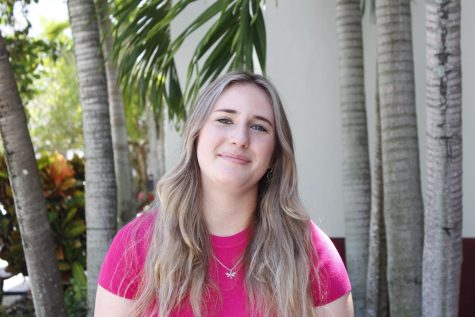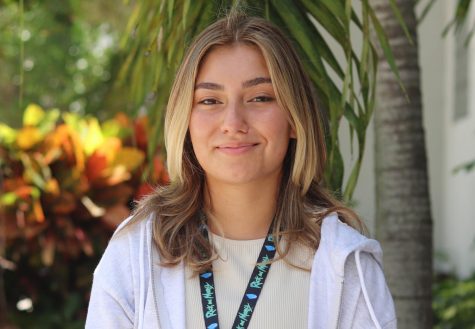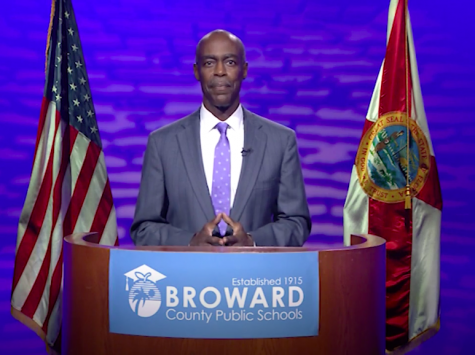COVID-19 pandemic alters many aspects of nation’s school system
Freshman Allan Burrows and sophomore Melina Carpio complete classwork in an Acting I class. Many aspects of in-person school have been altered due to the COVID-19 pandemic.
October 29, 2021
The bell rings loudly, alerting students that it is time to begin moving to their first period classes. They settle into their seats and listen to the morning announcements as they take out their supplies. The class commences and the students take notes, complete assignments and work on tests. At lunch, they sit with their friends and after school they attend club meetings and participate in sports. Despite many aspects of school remaining the same, this year is unlike any other school year.
Student’s face’s whose smiles were once put on display are now covered by face masks. Teachers encourage students to bring their own school supplies to limit cross contamination between individuals and utilize online resources during class time. Maintaining distance between others and frequently washing their hands have become the new normal for students and staff who have returned to campus in the midst of the COVID-19 pandemic.
Last year, with little-to-no notice, teachers and students alike found themselves in the middle of a huge national experiment in discovering new ways to teach and learn through virtual mediums.
The COVID-19 pandemic disrupted almost every aspect of traditional schooling and forced educators to rapidly adapt in order to fit the needs of the student body. The movement of classes to an online setting resulted in the reliance on sites like Canvas and Microsoft Teams to get through the school day, with the majority of schoolwork expected to be submitted virtually.
However, transitioning from in-person to remote learning was more than just a switch from classrooms to computers. While in-person schooling has resumed for the majority of students in the 2021-2022 school year, the pandemic has challenged our basic ideas of what school should look like, from technology to the structure of the classroom to mental health to the role that human connections play in education.
One of the most prominent changes from the move from online to in-person school is the requirement of face masks amongst other COVID-19 guidelines.
For Broward County Public Schools, face coverings are mandatory for students, staff and visitors at all district schools and facilities, including school buses. The masks must cover and fit snugly on the nose and mouth, with no gaps.
“According to the CDC, we have to follow certain protocols, one being to wear a mask and the other is social distancing,” Marjory Stoneman Douglas High School calculus and trigonometry teacher Shanthi Viswanathan said. “Some of the classes I teach have a capacity of 35 or over, so the least I can expect from my students is that they follow the mask mandate the same way that I do.”
Masks must be worn during classes and class changes. However, there are certain times throughout the school day where face masks are not mandated, such as during mealtimes, while engaging in strenuous physical activity, participating in athletics, and during music and theater performances. Additionally, masks do not have to be worn outdoors if a minimum of 3 feet of physical distance is maintained.
“Wearing a mask is a necessary thing that we have to do to keep us and everyone around us safe, but it does have some negative parts to it,” junior Manoela Ford said. “For me, the worst thing is the heat because it is already so hot out, and wearing a mask makes it worse.”
Students can be exempt from wearing a mask with an approved IEP, 504 Plan or Health Plan with signed documentation from a licensed medical professional.
However, the mask mandate is not entirely enforced. Students can often be seen wearing their masks below their noses when walking to other classes or standing outside in the morning. Many students take their masks off for the entirety of lunch, even after they are finished eating.
“Walking around campus and seeing students who are not wearing their masks properly is disrespectful and inconsiderate to everyone around them,” junior Olivia Alvarez said. “Not only are they putting themselves in danger, but they are also putting their peers’ health at risk, which is selfish.”
Other COVID-19 guidelines for BCPS include the encouragement of students and staff to fill out a Health Screening Examination before attending school each morning. The virtual checklist asks if the individual has had any symptoms that could indicate COVID-19 such as a fever, or if they had recently come into contact with someone who had tested positive for the virus.
A minimum of 3 feet is maintained between students in classrooms, hallways and indoor common spaces, when possible. There is daily cleaning of high frequency touch points and weekly disinfection. Moreover, BCPS continues to provide two nurses per school and offer voluntary COVID-19 tests at all schools as well as reinforce frequent hand-washing.
In contrast to the 2020-2021 school year, standard seating capacity has resumed on school buses, school cafeterias are open for meal service through the traditional food service line and all sports and athletic facilities are now open.
Another major change brought by the COVID-19 pandemic is the plan of many school districts to embrace an online learning program even after the pandemic induced remote learning is behind us.
Students at MSD will not have the option for e-Learning this year. Virtual classes are only available to student enrolled in Broward Virtual School or Florida Virtual School.
The COVID-19 pandemic has proven that remote learning is not for everyone with over 60,000 BCPS students being identified by the district as not meeting adequate academic progress. More than half of these students signed up for voluntary summer school in order to better catch up and prepare for the current school year.
The pandemic has also changed the structure of the classroom. This year, many teachers have set up their rooms with seats that are further spread out, eliminating whatever space was allocated for walking, in an already tight classroom space. Desks are no longer pushed together to form table groups, but instead are placed individually around the classroom to account for social distancing.
However, this is not true in every room. Some classrooms have returned to business as normal, with the only change being that teachers now must submit a seating chart to allow for contact tracing in the event that a student comes into contact with COVID-19.
“For the first time in my life, I have assigned seats in order to track my students, if, God-forbid, an outbreak happens at the school,” Advanced Placement Government and Politics teacher Jeff Foster said.
Moreover, many teachers are continuing to implement the learning materials they created during the pandemic for this school year.
Understanding students’ struggles in learning virtually during the pandemic, some teachers decided to record their lessons and post them on Canvas where students could easily access them. Having the opportunity to re-watch a lesson can help clarify a topic for students and enable them to do better on assessments.
In some instances, teachers have stopped asking students to take traditional notes in class, instead assigning pre-recorded videos for students to watch and take notes on for homework. This frees up class time for students to ask questions and to complete assignments that reinforce the information.
Another method of teaching that has carried over from the pandemic is Nearpod, a tool that allows teachers to create interactive presentations which allow students to take notes, watch videos, answer questions and post on discussion boards. Students can either use a join code to follow along on their own devices or watch on the teacher’s screen.
“I’m reusing Nearpods I made last year, because they’re a good tool to review and/or introduce a concept,” science teacher Tammy Orilio said. “I’m also using some general virtual activities for students who need to make up assignments that I’ve already graded and passed back to help reduce copying from the students who’ve gotten their work back already.”
While having many obvious negative impacts, for websites like Canvas, Quizizz and Remind, the pandemic has been more than beneficial.
“I already had Canvas before COVID, so I just became more robust in it, but that was a huge disadvantage for other teachers,” finance teacher Sharon Cutler said.
Throughout remote learning, these sites made online teaching easier and continue to help avoid the spread of germs in person this year. Teachers have been using these sites to teach and review lessons, as well as for getting in contact with their students, rather than printing out assignments on paper.
“I try to use less paper now,” Cutler said. “Instead of making copies like I used to, my students can read their assignments online or print it themselves.”
In this effort to prevent the spread of COVID-19 by limiting the amount of paper and supplies passed between students, some have also been forced to print out a majority of their papers and assignments rather than being handed them by teachers in school. For students who lack access to a working printer, this has posed a problem.
“My printer is old and often stops working. While the media center has a printer, it costs money, which I would have to spend money to print out my assignments everyday, an issue that I did not have before the pandemic,” senior Maegan Pierre said.
While in previous years many teachers gave students the option to borrow supplies such as staplers, pencils and calculators, this year many students are being encouraged to come to school with their own materials to limit the sharing of items between students.
“I encouraged my marine II students, who do a lot of dissections and need to wear goggles, to purchase their own goggles instead of the shared set that’s UV-sterilized, just for an added layer of safety,” Orilio said.
Some teachers still lend out their supplies, but many ask their students to wash their hands before and after they use the supplies and wipe down the item when they are done.
“Being a science teacher, I have to have students share materials,” Orilio said. “Some of them use disinfecting wipes before using shared materials, and I make sure everyone washes their hands at the end of the period. I have lots of sinks and soap for hand washing.”
Although students may have to deal with the added weight of paper handouts carried between school and home, they save the challenge of transporting a textbook, as many textbooks have moved to online platforms. As the use of online assignments and courses persists into 2021, the utilization of online textbooks follows with it.
Some teachers who have previously taken on collaborative teaching styles have adjusted their curriculum to avoid group assignments in an effort to reduce contact between students.
Another change the pandemic has brought to the school system is the importance of students’ mental health. The mental health battles of the nation’s students will outlast the pandemic and thus require school districts to create a strong system of support for the student body.
“[The pandemic] made it harder to hash out issues with friends that you would see in-person on a daily basis because they no longer feel obligated to respond to you, which made my mental health suffer as I had more unsolved issues than pre-pandemic,” junior Jason Choy said.
An August 2021 report by the Child Mind Institute revealed that there has been an increase in the number of students who report feeling depressed or anxious. Furthermore, over 75% of students who receive treatment for their mental health do so at school.
As the demand for mental health care rises, school districts have had to adapt through hiring more counselors and mental health providers. Some schools have hired therapists to aid students on campus.
Additionally, a new app entitled “Tell Another. Listening is Key” is one of three new initiatives released by Broward County Public Schools to support students with mental health resources. The T.A.L.K. app was published on students’ learning platforms, providing K-12 students with the opportunity to confidentially request mental health support or report abuse. After submitting a form through the app, the student will be connected to a mental health professional before the end of the next school day.
Various 24/7 mental health hotlines have been made available to students such as the Crisis Text Line which can be reached by texting “HOME” to 741741.
The pandemic has also permanently changed the college admissions process. For decades, the SAT and ACT have been a mandatory part of applying to college. However, for the class of 2021, many competitive universities across the nation decided to change their admissions process, acknowledging the multitude of hardships students have faced over the past year that may have prohibited them taking and getting a decent score on the tests.
In a February 2021 survey conducted by ACT, many colleges answered that they were unlikely to return to requiring the tests in the future. Over the next few years, colleges will learn whether eliminating the testing mandate means they will be enrolling a more economically and racially diverse class of students. Additionally, universities will be able to see how students admitted without test scores do compared to those who submitted theirs.
“I’m really intrigued by the fact that this change could take place,” junior Tilak Patel said. “Having the ability to not submit my test scores might affect where I decide to apply to college.”
For the majority of students, their days of remote learning have been put behind them. In-person classes resume, clubs are able to host events, sports seasons commence and students have been able to regain some sense of normalcy.
In the past, the American school system has been criticized for its resistance to change. However, the past year has shown that the system can be changed to better meet the needs of students across the nation.
This story was originally published in the October 2021 Eagle Eye print edition.























